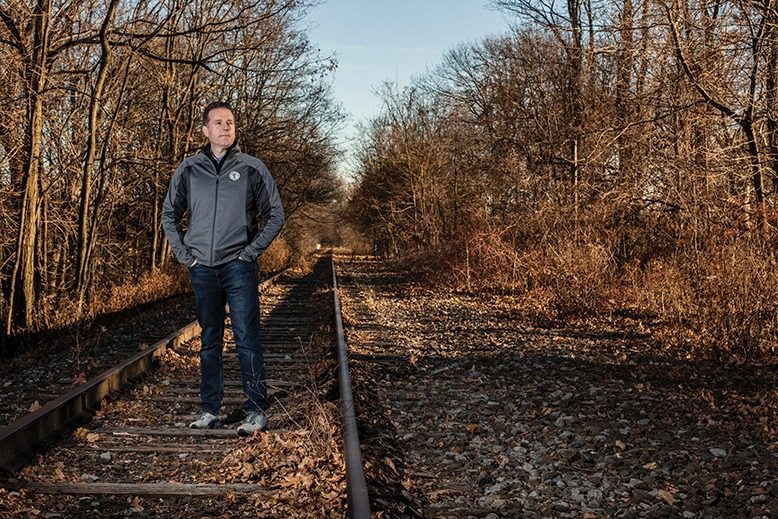
Imagine if New Jersey had its own version of New York City’s popular High Line—a beautiful walking and biking trail with gardens, benches and scenic views along the way.
That vision will soon become a reality now that Governor Phil Murphy has pledged to purchase nearly 9 miles of an unused rail line, stretching from Montclair to Jersey City, for a new state park called the Essex-Hudson Greenway. The train tracks will be removed and the park will feature a pedestrian and bike trail that will run for the entire distance of the former rail line.
For more than a decade, communities along the former Boonton rail line had been campaigning to have it turned into a linear park—or one that is longer than it is wide—that could be used as a trail for walkers, runners and cyclists. The rail line, which is about 100 feet wide in most places, was rarely used after the Midtown Direct train line was created back in 2002. It had fallen into a state of disrepair, with graffiti and garbage littering the path.
Soon, it will be transformed.
“It was an incredible day when we received word from the governor’s office that it would commit to help finance a once-in-a-lifetime transformational project. What it means for the region is unbelievable—not just Essex and Hudson counties, but for the entire state,” Essex County Commissioner Brendan Gill tells New Jersey Monthly.
The 135-acre park will likely open in stages, as there are many steps before a construction timeline can be made, says Gill. He anticipates that certain portions of the trail will open in a few years. The Greenway will start in Montclair and pass through Glen Ridge, Bloomfield, Belleville, Newark, Kearny and Secaucus, ending in Jersey City. The trails will journey through the wild marshes of the Meadowlands and over the winding Passaic and Hackensack rivers.
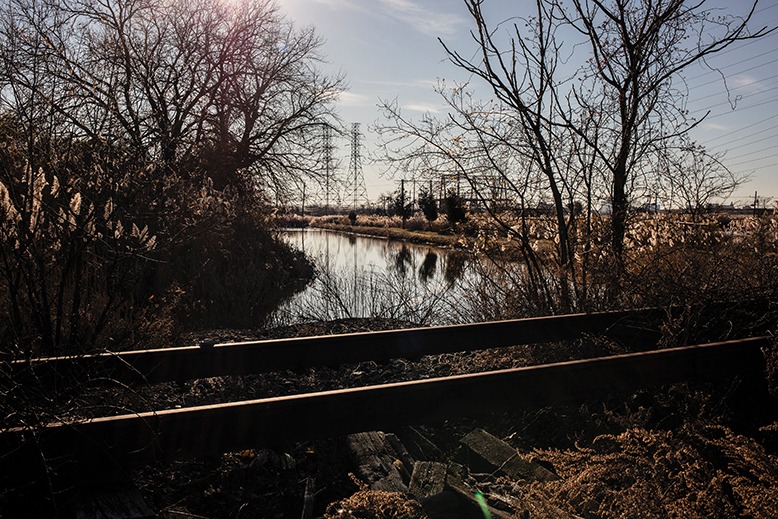
The trail will pass through the Meadowlands, including this portion in Kearny. Photo by Bryan Anselm
The Greenway’s goals are many. It aims to ease traffic, providing an opportunity for commuters to leave their cars at home on their way to other parts of New Jersey or via public transportation to New York, reducing pollution. It will offer green space for urban areas, and it is expected to be an economic engine for many communities, with park goers enjoying access to local shops and restaurants along the trail. It will also provide a safe place for bike riding and walking, without the danger of sharing the road with cars and trucks.
Gill has been working for the past 10 years to help bring the project to fruition. The land is being purchased from Norfolk Southern Railroad at a cost of $65 million.
He extolls the many advantages of the Greenway, such as using portions of it for stormwater mitigation—crucial at a time when flooding in the region is worsening. He also cites the social justice aspect of creating new green space for communities in cities such as Newark and Jersey City, where there are few options for residents to bike or walk in nature. The trail will also connect suburbs to cities, and it will help to maintain property values for those living along the unused rail line.
“This project has been years in the making, and I am proud to be the governor to advance this dream to being a reality,” Governor Murphy said when announcing the Greenway deal in November. “This new park will be a crown jewel of our state park system, providing much-needed recreational space to New Jerseyans and out-of-state visitors, while revitalizing and protecting environmentally sensitive areas.”
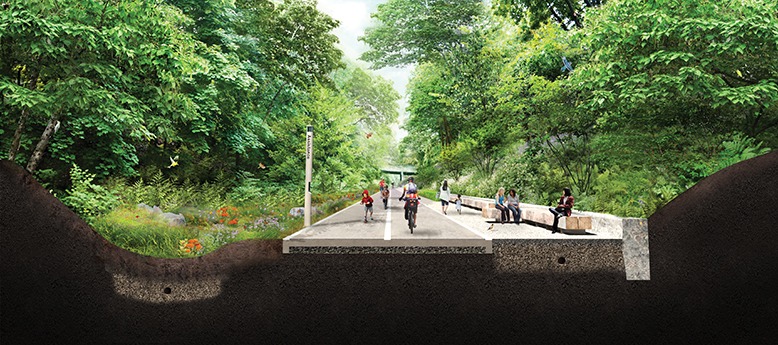
A rendering shows Montclair’s future portion of Greenway. Courtesy of Mathews Nielsen Landscape Architects/Open Space Institute
Jersey City Mayor Steven Fulop says the Greenway is “a once-in-a-generation type of opportunity to create an infrastructure that will be a legacy for New Jersey and for Jersey City. Having our city as an ultimate destination for the Greenway is going to be a huge benefit for our residents and our businesses.”
An early supporter of the project, Fulop says the Greenway will be especially beneficial for his city’s vibrant cycling community. Jersey City has invested generously in protected bike and pedestrian lanes in the city and is in negotiations with Conrail to purchase an elevated rail corridor known as the Embankment and turn it into more pedestrian lanes.
Fulop says that the Greenway will connect with the Embankment and another former rail line, the Bergen Arches, leading pedestrians and cyclists directly to the Jersey City waterfront. The city is also constructing bicycle-storage pods for for those who wish to commute to New York City via the PATH train, which is about a quarter of a mile away. “We’re focusing on walkers and cyclists over cars in Jersey City,” Fulop says.
ZOMBIE TRACKS
In Newark, much of the unused Boonton rail line has become unsightly and even dangerous, says State Senator Teresa Ruiz, who grew up near the tracks in the city and still lives in the same area.
She says that the homeowners whose houses abut the tracks have been casualties of the neglected land, and that Norfolk Southern had been renting out portions of the line to businesses to store items like wood and trucks.
“We called them zombie tracks. It became a place where people were using it as a dumping ground,” she remembers. “It created a magnet for potentially inappropriate behavior.”
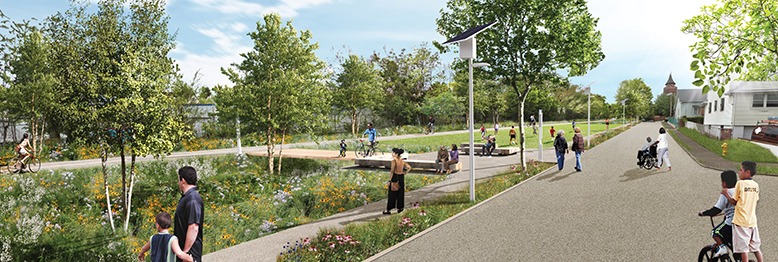
An artist rendering shows the future Greenway in Newark. Courtesy of Mathews Nielsen Landscape Architects/Open Space Institute
Ruiz, who on January 11 was sworn in as New Jersey’s Senate majority leader, says she’s thrilled that the land will finally be cleaned up and become a green space for residents of Newark, as well as the rest of the state.
“This is truly an historic moment. It’s big for the state and for the two counties that will benefit. For the city of Newark, it’s an even bigger win. We’re number one in population in the state, so the more we’re able to acquire open space for the next generation to enjoy, the better,” she says. “When you get an opportunity like this, it’s extraordinary, without a doubt. It’s the most amazing thing that any government could do.”
Ruiz is also looking into whether the light rail in Newark could be connected to the Greenway trail, so that it could be extended along the former rail line, possibly even to Secaucus. She also suggested that the city could one day fund an electric van that could pick up passengers and their bikes at the trail in Newark, and take them downtown, which is about four miles away.
She’s excited that her own 5-year-old daughter will one day be able to use the trail and says that the city kids who attend the Park Elementary School across from the park and the residents in a senior center nearby will also greatly benefit.
Gill agrees that providing more green space to residents in the state is a game-changer. “Once it’s finished, this will be New Jersey’s version of the High Line. In a densely populated and urban area, people will have access to nature and recreational activities. And it will link communities in ways they are not already connected,” says Gill. “This no longer becomes a question of if, but when.”
HOW IT STARTED
Gill says the project first came to his attention in 2011, when he spoke with a group of local activists from Montclair, Bloomfield, Nutley and Glen Ridge who were advocating for the conversion of the rail line into a trail.
Richard Webster, an attorney from Montclair who is now legal director of Riverkeeper, an environmental organization dedicated to the protection of the Hudson River and its tributaries, was one of the original proponents of the concept. He says that after the Midtown Direct rail line commenced in 2002, he wondered what would happen to the portion of the tracks from Montclair to Jersey City that was no longer being used by commuters. This was the old NJ Transit Boonton line, which Norfolk Southern owns and occasionally used. He thought it would make a great rail trail.
He contacted a friend, David Wright, also of Montclair, and after the pair walked the tracks, they began working on getting local towns to sign onto the idea. The Bloomfield Open Space Trust Committee was one of the first local organizations to get on board.
Webster and Wright initially called the concept the Iron and Ice Trail, after learning that the train line was once used to transport iron and ice from Greenwood Lake into New York City. Soon, they created a website and were making homemade Iron and Ice Trail T-shirts in their backyards. Eventually, the idea started to gain momentum as more towns agreed to back the idea.
The name for the trail was later changed to the Essex-Hudson Greenway.
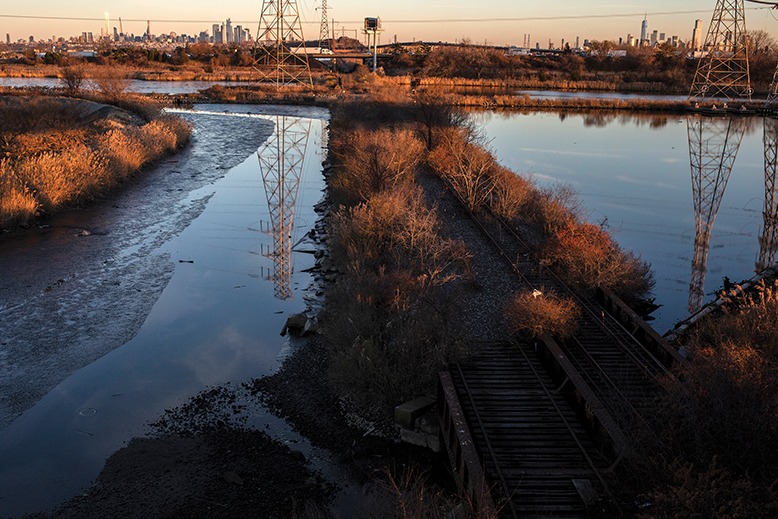
Unused train tracks, like these shown in the Meadowlands, will find new purpose with the Essex-Hudson Greenway. Photo by Bryan Anselm
In 2014, the New Jersey Bike & Walk Coalition and the September 11th National Memorial Trail Alliance partnered in supporting the Greenway campaign and began advocating for the purchase of the unused rail line and the transformation of the land into a park.
Initially, Norfolk Southern wasn’t interested in selling the line, and advocates were afraid the company might sell the land off in pieces. When it finally became apparent that Norfolk Southern was, indeed, open to selling, the Open Space Institute, a regional land-conservation organization that helps protect scenic, natural and historic landscapes, was tapped to help negotiate with the company.
Dene Lee, the institute’s senior director for the Northeast Land Program, says they have been at the table with Norfolk for three years now, hammering out a deal. In 2019, the groups reached an agreement to purchase the property from Norfolk Southern for $65 million, but they didn’t have all the funding until now.
The State of New Jersey will purchase the line using a variety of funding sources, including American Recovery Plan funds and Green Acres land-acquisition funds, says Lee. Some funding will come from NJ Transit, which will use a portion of the line for temporary construction access to the Portal North bridge project over the Hackensack River, and a portion of the line may be used for future transportation purposes, which are currently under study, according to Nancy J. Snyder, chief communications officer for NJ Transit. (At press time, the Open Space Institute was still working on closing the real estate transaction.)
For Webster and the others who nearly 20 years ago initiated the process of turning the overgrown rail line into a trail, the news that the Greenway will actually happen has been transformative. “It’s wonderful to see a great aspiration turn into a concrete reality. The trail connects lots of open space throughout the counties in a beautiful way; it connects Branch Brook Park with the Meadowlands, and it connects a diverse range of communities. It will turn a rail line that attracted dubious activities into an area where it will really enhance the community. It will turn a negative into a huge positive,” says Webster.
JERSEY’S HIGH LINE
Many supporters compare the concept for the Essex-Hudson Greenway to the popular High Line, a 1.45-mile-long elevated park, greenway and trail created on a former New York Central Railroad spur on the west side of Manhattan. The first section of the park launched in 2009, after an advocacy group pushed for it to be turned into a park rather than the planned demolition.
The High Line was modeled on a similar park that opened in Paris in 1993, known as the Coulée Verte René-Dumon. Both parks have inspired other cities around the world to transform unused industrial zones into vibrant public spaces.
The Cape Cod Rail Trail is another linear park that inspired advocates for the Greenway. It’s a popular, 25.5-mile paved rail trail that passes through seven towns on Cape Cod in Massachusetts. The trail, built on a former rail line, passes freshwater ponds, shops and restaurants along the way. It has become an integral part of the culture of the region.
That’s something advocates of the Greenway hope will happen in New Jersey. For now, they are celebrating a huge victory in attaining the first new state park since 2006. “This is just the very beginning,” says Debra Kagan, executive director of the New Jersey Bike & Walk Coalition. “…We had a lot of community support, and we’ll need community input going forward.”
